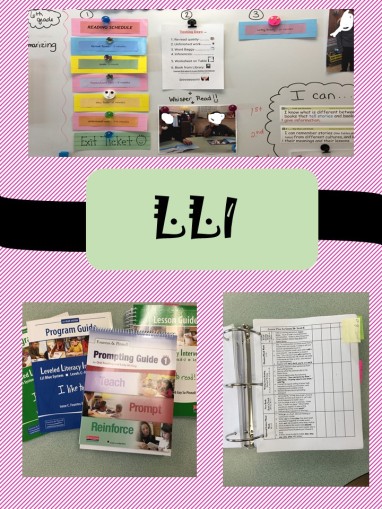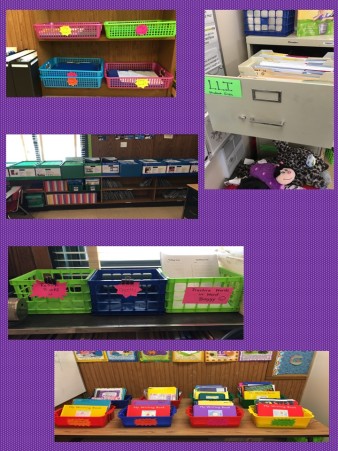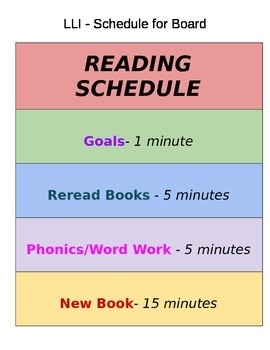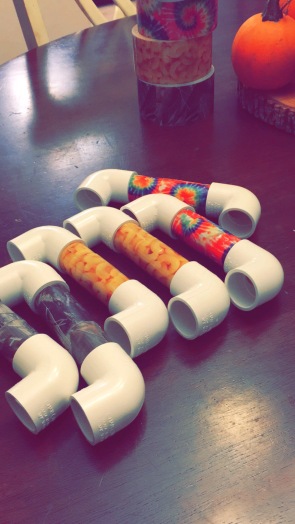Hello!
I figured I would write a little bit about the program I use with my students, so if you’re a parent you’re able to see what your student does with me throughout the week and if you’re an educator you are able to see how I implement the program.
The LLI kits support below grade level students who struggle in reading and writing. They are not for whole class lessons, but rather small intimate group settings, no more than 4-6 students in a group. There are different colored kits (orange, green, blue, red & gold). I have the green and blue kits which are for levels 1-3.
Leveled Literacy Intervention is a scientifically-based program that works with struggling readers so they are able to reach the level they need to be on. The program is fast paced and provides students with comprehension, fluency, writing, phonics, & vocabulary throughout each lesson. The majority of the program focuses on fluency and writing.
As mentioned above, I work with the green kit (1st grade) and blue kit (2nd-3rd grade). There are 110-120 or so lessons in each kit. Each lesson has 4 colored copies of the book and 6 black & white copies (take home books) or each book.
The program supplies canvas bags with a spot that fits an average sized index card in it perfectly which I place their name on to take their black and white copies of the book home to read and return.
The teachers manual walks you through each lesson verbatim, but on TpT I purchased the lessons printed out on single pages that I placed in a binder which has made it a lot easier with planning. There is also aPrompting Guide and resource book: When Readers Struggle: Teaching That Works which are available in the kit. The Prompting Guide is a great tool to use because it targets reading behaviors and gives you word-for-word what you are able to say to guide your student.
Each lesson takes about 30 minutes to teach. The kits come with a large variety of high-interest texts: fiction, non-fiction, classic tales and series books (Meli, The Fun Club, etc.). Each level has 10 lessons that are numbered. The even lessons introduce the New Book (on their level) and the odd lesson is book on their independent level to build fluency.



I set my week up in 3 days. I see my students 3 times a week/30 minutes a session.
I needed to figure out a way to touch upon each part of the program that works best for me and my students.
On my board (so the students can see the schedule as well and get used to the routine) I have a 3 day schedule:
Day 1: Reading Schedule
Re-read quietly – 5 minutes
Goals – 1 minute
Phonics/Word Work- 5 minutes
New Book – 15 minutes
Letter/Word Work – 5-10 minutes
Exit Ticket
Day 2: Testing Day Schedule
(While I am calling 1-2 students over to do a reading record)
- Re-read quietly
- Unfinished sentences in Writing Book
- Word Bags (the word cards – quiz a friend, play memory)
- Worksheet on Table (one of the fold sheets if unable to get to the day before)
Then I continue with our independent reading book for that day following the teacher’s manual.
Day 3: Writing Day
In their writing book (LLI comes with red, yellow and purple writing books with blank pages in it – the colors mean nothing other than allowing the children to have a choice and the blank pages which are for beginner writers to use. It allows them to not get distracted and concentrate so much on filling up the lines, but rather to be concious of placing the print on the page rather than just filling up the lines. When finished the story or sentences they wrote can be easily read without the distraction of any lines on the paper).

Let’s get into the different pieces of the lesson now….
Phonics/Word Work:
This is a quick piece before starting the book for the day. Students are explicitly and systematically taught during this part. The kits provide, Alphabet &b Consonant Cluster Charts (we just do all of our work in our writing book not to waste more paper), poems, letter and word games, and lists of suggested words (what I send home in their ‘word baggies’). I like to try and incorporate magnetic letters with cookie trays, children going up to the board to write, highlighting in our poem book, and using colored pens in our writing book. There are many great apps that work on phonics as well (see my previous post).
New Book:
This is when the instructional leveled book gets introduced to them. I always discuss the cover photo, genre, title and then do a picture walk stopping at words I think may be difficult for them while discussing the spelling rule for that word and definition. I then give a book to each child and have them use my whisper phones that I made. NO ROUND ROBIN READING (where you go around and each child reads a page in the book) it DOES NOT build on fluency and because of the constant picking of names and changing rate of reading the comprehension is then lost. I LOVE whisper reading. I start my group off at different points, so they aren’t hearing each other read at the same point, and they use the whisper phones that magnify their voice into their own ear. I am then able to hear each of them, stop them to ask questions individually and they know instead of interrupting to ask what a word is, they point to it and look at me. Don’t popcorn read in small reading groups! It just doesn’t work and is outdated.

Writing:
LLI has a writing component. It is split into three different ways to teach writing: interactive, dictated, independent. I like to switch it up, or do even more then one way at a given time.
*Interactive writing: This is when we work together. The children write on chart paper, or the board and we compose sentences, or a story about what was read taking turns and brainstorming together.
*Dictated writing: This is when I say sentences and they write it down on their own. Some students have a difficult time hearing all of the spoken words and putting it down into their writing book. I realized using a manipulative of some sort to have them put it down for each word they hear in the sentence allows them to make sure they aren’t missing a word. I like them to also listen to the sentence first and visualize it, then if they need to place the manipulative down, then write.
*Independent writing: This is when the student write on his/her own in their writing book. They usually do this mostly on testing days while I am doing reading records with other children. This allows me to see their growth throughout the school year.
Mrs. K ♥

No comments